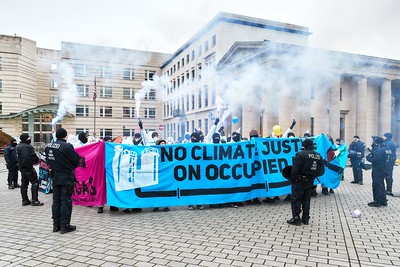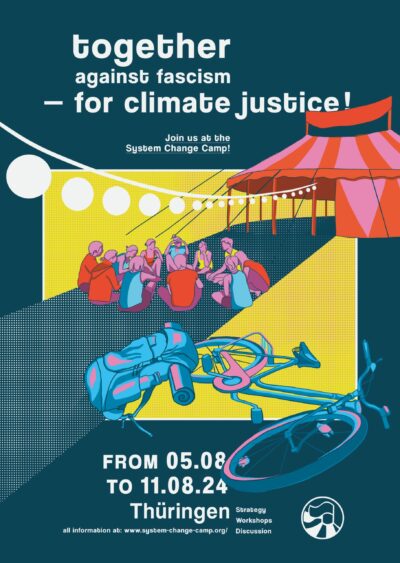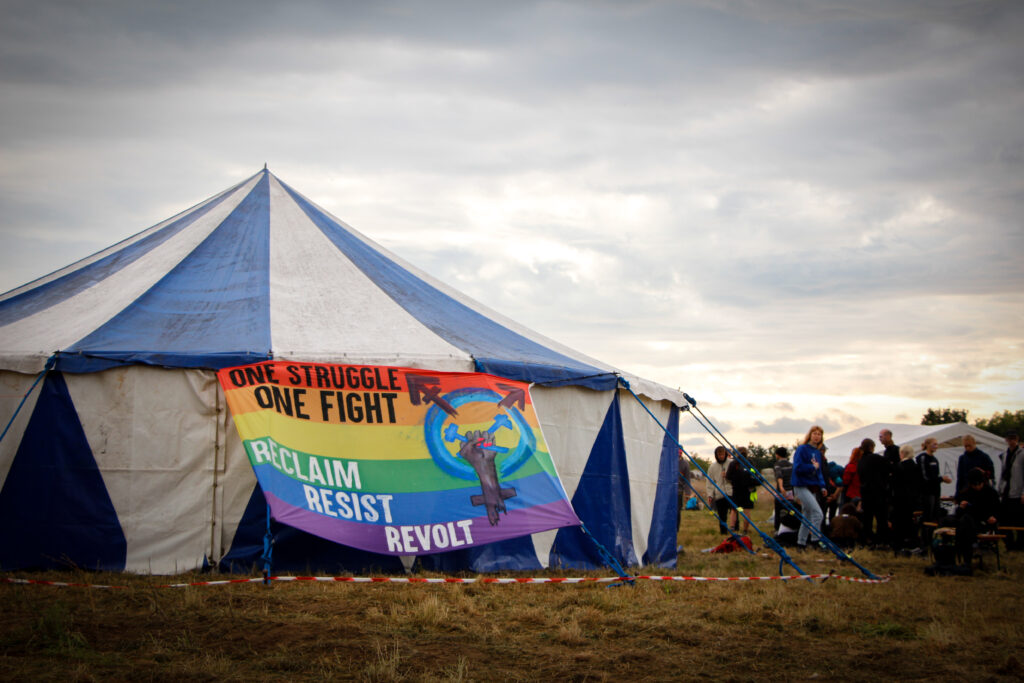Antiracist Infomail #3 – Cultural Appropriation
In our Antiracist Infomail #3 we would like to discuss cultural appropriation at Ende Gelände and in the climate justice movement as a whole and to encourage people to inform themselves about the issue.

Dear people fighting for climate justice,
In our Antiracist Infomail #3 we would like to discuss cultural appropriation at Ende Gelände and in the climate justice movement as a whole and to encourage people to inform themselves about the issue. We mainly talk about Black hairstyles, especially locks, which are very common among white people in “left” and “alternative” scenes. But it is important to say that this is not the only form of cultural appropriation in the German climate movement! In this mail we refer to the demands from an Open Letter from BIPoC (1) to the German climate justice movement. The link to the letter can be found below.
Demand 4: “We demand that white organizers and participants critically question their own position and privileges. Unfortunately, white dreads are still a symbol of recognition of eco-activism and many left-wing scenes” (2)
In this mail we mainly address white (3) people.
What is cultural appropriation?
In the context of racism, cultural appropriation occurs when white people adopt symbols, objects and practices from a marginalized culture for their own benefit, while the marginalized group is racially discriminated against for bearing the same cultural elements. Since colonialism, white people have defined the “other” and exploited them. This continues today in the form of cultural appropriation. For example, when museums continue to exhibit colonial looted goods, profit financially and do not even consider returning them. White people thus continue to profit from colonialism, while at the same time they continue to racially devalue Blacks, Indigenous and People of Color as “uncivilized”.
Cultural appropriation can be directly linked to material profit, as in museums, pop culture and the fashion industry. However, profit can also be non-material or symbolic. BIPoC and marginalized cultures are on the one hand made invisible and devalued by cultural appropriation, but at the same time exploited.
Where does cultural appropriation exist in the climate justice movement?
In the climate justice movement, the wearing of locks by white people is very common. Many BIPoC and people who deal with anti-racism and colonialism see this as a form of cultural appropriation.
Term “locks”
There are different positions on the term “dreadlocks” and we feel insecure in its use. The word “dread” could evoke a negative connotation in reference to “dreadful”. Therefore, the use is criticized by some BIPoC. Since “locks” is also understandable and we want to use sensitive language as much as possible, we use the term “locks” (if you have more knowledge about the discussion, we would be very happy if you share it with us).
Locks historically
The rejection of white beauty norms by Black people is closely linked to the emergence of the Black Civil Rights Movement in the USA, Black Nationalism and Black Power Movements: these movements used and still use the conscious appropriation of “natural” Black hair as an anti-racist resistance practice against white oppression and experience repression for this resistant act.
Why is carrying by white people problematic?
“Do not imitate being Black or deny your own whiteness. You don’t become less white if you come from a socially disadvantaged family. You are no less white if you try to grow dreads or imitate Blacks. You don’t mean any harm, but unfortunately you behave like a “good colonizer”: You make use of Black symbols, even the liberation symbols, appropriate them, play with them and in return you get attention and/or admiration from the other whites for your “courage” and your extravagance. The Black symbols are ridiculed because they are reinterpreted and occupied by Whites. So far, most of the Black cultural contributions have been appropriated and distorted by whites. (…) You should be aware that you can help yourself from any culture because of your whiteness and still exert power. Because many Black Germans don’t find this combination funny at all, we don’t want to congratulate you on your dreadlocks.”
(Sow, Noah (2009): Germany Black & White: The everyday racism. Munich: W. Goldmann, p. 251-252. Quoted from https://maedchenmannschaft.net/schwarze-widerstandssymbole-auf-weissen-koepfen/, free translation)
While for Black people the wearing of locks or “natural hair” means resistance and is associated with racial discrimination, white people are praised for wearing locks and are considered “cosmopolitan” or “stylish”. Here, power relations are actively reproduced: The white person retains their privileges, their appearance can be dropped at any time, while racism against Black people is maintained.
For white people, locks are often seen as an “alternative fashion trend”, whereas locks for Black people are often racially devalued by the white majority society as “unprofessional”, “unkempt” or similar and the wearers are discriminated against. The problem of appropriating locks can therefore only be understood if the existing racist power relationship and the experience of BIPoC is seen.
Locks were and are also used by Black people as a sign of political resistance. To see the same symbol in white people who are not exposed to racist attributions by wearing locks, or even celebrated for their “courage” or “free spirit”, can offend BIPoC.
The fact that so many white climate activists walk around on climate camps and in actions with locks has been publicly mentioned by BIPoC several times as one of the reasons why many often cannot feel comfortable in the climate movement in Germany. Nevertheless, little has changed. White people often do not accept the criticism of cultural appropriation expressed by BIPoC. This approach is part of white privileges: white people live in the belief that they have the power of interpretation over the legitimacy of all their actions. This way of thinking is not questioned by the white majority society.
How do we think this should be handled?
- The pain in BIPoC caused by white people wearing locks should be recognized and taken seriously. Attention: Maybe you know BIPoC who say that they do not find the wearing of white locks offensive. If this is really the case, we are happy for the person. But this does not mean that other BIPoC can’t have good reasons to be hurt by white locks (just because a woman says that a sexist act is okay for her, does not mean that you are allowed to behave like this towards all women).
- Share the knowledge about the background of locks and the mechanism of cultural appropriation. It is the responsibility of everyone, especially white people, to critically reflect on their position and their actions. You are welcome to forward this mail, but you can also organize a reading circle or an event about the topic.
- Inform yourself about other practices of cultural appropriation performed by you and in your environment. If you have a feeling of uncertainty about cultural appropriation of certain things you do, take this feeling seriously. Search for information on the subject. If you don’t find anything about it or if information is contradictory, it doesn’t mean that it can’t be cultural appropriation. Do not wait for the moment when you hurt a person. It is better to refrain from an action or take more time to think about it than to take the risk of hurting people.
- Talk to your friends and in your political groups about the topic. Don’t wait for the moment when a Black person or Person of Color have to criticize you or your white friends. White people also have the responsibility to criticize racist behavior.
- Although we think it is important that you (to white people!) reflect critically about cultural appropriation among yourselves, we also think it is important to consider different levels of knowledge and to treat each other with respect. It is not about excluding individual people from the scene or publicly denigrating them, but about initiating structural anti-racist changes.
- If you criticize other people: Check your position! All, especially white people, reproduce racism because we are socialized in a racist system. All people have at some point started to deal with the issue and nobody can claim to have completed the process. So, criticize racist behavior of others, but don’t forget that you are not free of racism either!
It is not possible here to describe the full extent, history and consequences of cultural appropriation. What we write in this mail is not something we invented, but a summary of BIPoC’s analysis and arguments on the topic of cultural appropriation. Here you can find further materials:
Articles:
Mädchenmannschaft: Schwarze Widerstandssymbole auf weißen Köpfen:
https://maedchenmannschaft.net/schwarze-widerstandssymbole-auf-weissen-koepfen/
Mädchenmannschaft: Die Politik Schwarzer Haare:
https://maedchenmannschaft.net/die-politik-schwarzer-haare/
Noa Ha: Kulturelle Aneignung und koloniale Gewalt:
https://missy-magazine.de/blog/2016/11/03/kulturelle-aneignung-und-koloniale-gewalt/
Hengameh Yaghoobifarah: Tante Ernas Knochen im Museum:
https://taz.de/Ueber-Rassismus-reden/!5356157/
Hengameh Yaghoobifarah: Fusion Revisited:
Karneval der Kulturlosen: https://missy-magazine.de/blog/2016/07/05/fusion-revisited-karneval-der-kulturlosen/
Videos:
Bildungsstätte Anne Frank- kulturelle Aneignung: https://youtu.be/4yVdToFuXe4
Karakaya Talk, Blackfishing: Bist du Schwarz oder tust du nur so? https://www.youtube.com/watch?v=-dw334F6ngA
Karakaya Talk, Blackfishing: Fame für dich, Hate für mich. https://www.youtube.com/watch?v=Cf1v2BB9Wbc
My Culture is not a Costume: https://www.youtube.com/watch?v=d6Y5cARFJw8
Podcasts:
Feuer und Brot: kulturelle Aneignung, Blackfishing und “Digital Blackface”:
https://www.feuerundbrot.de/folgen/kultutelleaneignung
https://www.feuerundbrot.de/folgen/kultutelleaneignungbonus
Book:
Alice Hasters: “Was weiße Menschen über Rassismus nicht hören wollen, aber wissen sollten”. Kapitel “Ich wäre auch gerne Schwarz” S.80-93 oder als Podcast: https://open.spotify.com/artist/6Q9TEp2IQdMNmq3WwMrerS
We hope you can take some food for thought and reflect about cultural appropriation in your groups. Feel free to write us feedback!
Solidarity greetings,
your Antira AG from EG Berlin
P.S.:
Our Infomail #1 General Recommendations is here: https://www.ende-gelaende.org/en/news/anti-racist-infomail-1/
Our Infomail #2 Tokenism is here: https://www.ende-gelaende.org/en/news/antiracist-infomail-2-tokenism/
(1) BIPoC: BIPoC stands for Black, Indigenous and People of Color. The term, which originates from the US-American civil rights movement, is a self-description and does not describe the biological characteristics of humans, but a social construction that assigns people a certain social position. What BIPoC have in common are shared experiences of racism, exclusion from the white-dominated majority society, and collective attributions of “otherness”. The concept sees itself as emancipatory and in solidarity. It positions itself against attempts at division through racism and culturalization as well as against discriminatory designations by white majority societies.
(2) The letter from BIPoC to the climate camp and others can be found here: https://www.dropbox.com/s/n42ly8wbgyl0mhu/Offener%20Brief%20von%20BPoCs%20an%20das%20Klimacamp%20und%20andere.pdf?dl=0
(3) white: white, in contrast to terms like Black and People of Color, is not a political, empowering self-description, but describes a dominant position that is usually not named. The name serves to make white privileges visible, because they are usually invisible to white people. Racism also structurally assigns white people a certain social position. This position is associated with privileges, dominance and a standard for judging non-white, without itself being marked white. To make clear that whiteness is not an empowering self-designation, we write it in white small and italic letters, in contrast to the empowering self-designation Black, which we write in capital letters and non-italic.




